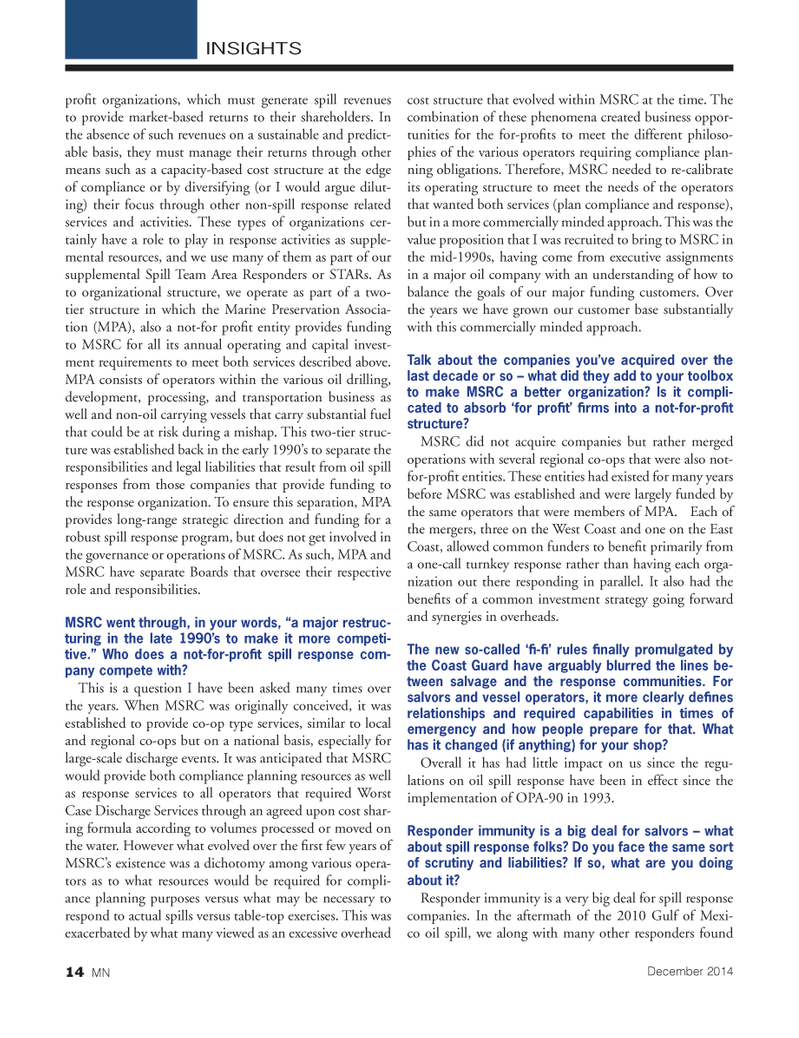
Page 14: of Marine News Magazine (December 2014)
Salvage & Spill Response
Read this page in Pdf, Flash or Html5 edition of December 2014 Marine News Magazine
INSIGHTSproÞ t organizations, which must generate spill revenues to provide market-based returns to their shareholders. In the absence of such revenues on a sustainable and predict- able basis, they must manage their returns through other means such as a capacity-based cost structure at the edge of compliance or by diversifying (or I would argue dilut- ing) their focus through other non-spill response related services and activities. These types of organizations cer- tainly have a role to play in response activities as supple- mental resources, and we use many of them as part of our supplemental Spill Team Area Responders or STARs. As to organizational structure, we operate as part of a two- tier structure in which the Marine Preservation Associa- tion (MPA), also a not-for proÞ t entity provides funding to MSRC for all its annual operating and capital invest- ment requirements to meet both services described above. MPA consists of operators within the various oil drilling, development, processing, and transportation business as well and non-oil carrying vessels that carry substantial fuel that could be at risk during a mishap. This two-tier struc- ture was established back in the early 1990Õs to separate the responsibilities and legal liabilities that result from oil spill responses from those companies that provide funding to the response organization. To ensure this separation, MPA provides long-range strategic direction and funding for a robust spill response program, but does not get involved in the governance or operations of MSRC. As such, MPA and MSRC have separate Boards that oversee their respective role and responsibilities. MSRC went through, in your words, ?a major restruc- turing in the late 1990?s to make it more competi- tive.? Who does a not-for-pro t spill response com- pany compete with?This is a question I have been asked many times over the years. When MSRC was originally conceived, it was established to provide co-op type services, similar to local and regional co-ops but on a national basis, especially for large-scale discharge events. It was anticipated that MSRC would provide both compliance planning resources as well as response services to all operators that required Worst Case Discharge Services through an agreed upon cost shar- ing formula according to volumes processed or moved on the water. However what evolved over the Þ rst few years of MSRCÕs existence was a dichotomy among various opera- tors as to what resources would be required for compli- ance planning purposes versus what may be necessary to respond to actual spills versus table-top exercises. This was exacerbated by what many viewed as an excessive overhead cost structure that evolved within MSRC at the time. The combination of these phenomena created business oppor- tunities for the for-proÞ ts to meet the different philoso- phies of the various operators requiring compliance plan- ning obligations. Therefore, MSRC needed to re-calibrate its operating structure to meet the needs of the operators that wanted both services (plan compliance and response), but in a more commercially minded approach. This was the value proposition that I was recruited to bring to MSRC in the mid-1990s, having come from executive assignments in a major oil company with an understanding of how to balance the goals of our major funding customers. Over the years we have grown our customer base substantially with this commercially minded approach. Talk about the companies you?ve acquired over the last decade or so ? what did they add to your toolbox to make MSRC a better organization? Is it compli- cated to absorb ?for pro t? rms into a not-for-pro t structure? MSRC did not acquire companies but rather merged operations with several regional co-ops that were also not- for-proÞ t entities. These entities had existed for many years before MSRC was established and were largely funded by the same operators that were members of MPA. Each of the mergers, three on the West Coast and one on the East Coast, allowed common funders to beneÞ t primarily from a one-call turnkey response rather than having each orga- nization out there responding in parallel. It also had the beneÞ ts of a common investment strategy going forward and synergies in overheads. The new so-called ? - ? rules nally promulgated by the Coast Guard have arguably blurred the lines be- tween salvage and the response communities. For salvors and vessel operators, it more clearly de nes relationships and required capabilities in times of emergency and how people prepare for that. What has it changed (if anything) for your shop?Overall it has had little impact on us since the regu- lations on oil spill response have been in effect since the implementation of OPA-90 in 1993. Responder immunity is a big deal for salvors ? what about spill response folks? Do you face the same sort of scrutiny and liabilities? If so, what are you doing about it?Responder immunity is a very big deal for spill response companies. In the aftermath of the 2010 Gulf of Mexi- co oil spill, we along with many other responders found 14 MNDecember 2014MN Dec14 Layout 1-17.indd 14MN Dec14 Layout 1-17.indd 1411/24/2014 3:52:42 PM11/24/2014 3:52:42 PM

 13
13

 15
15
